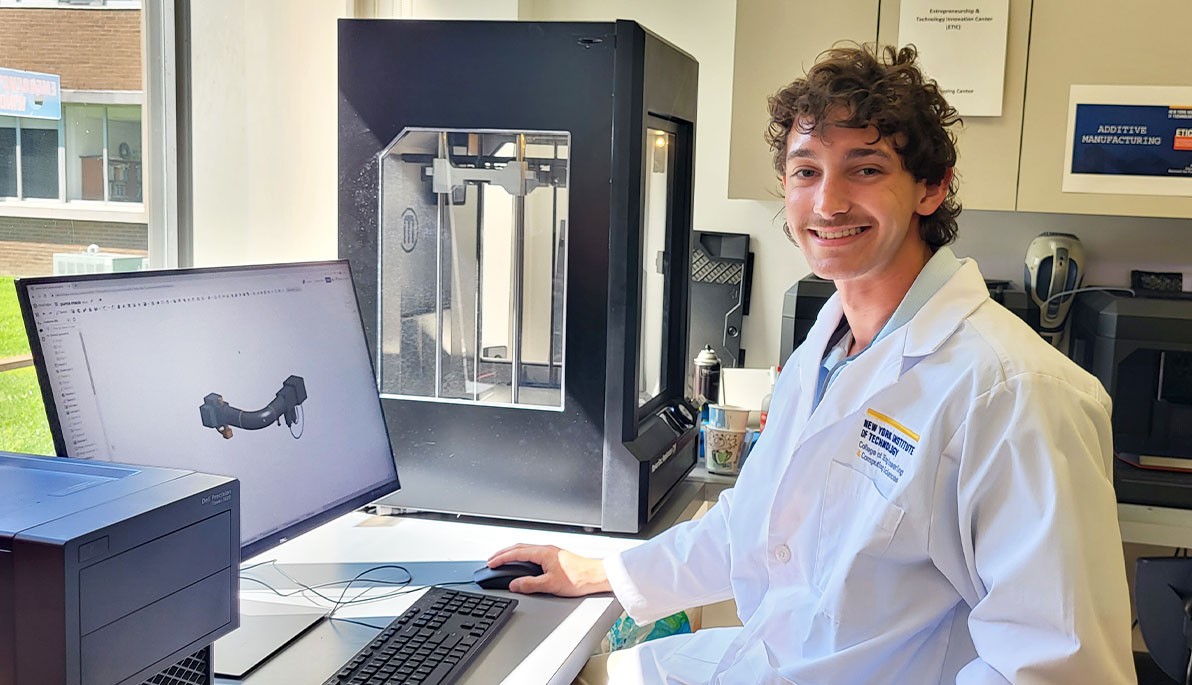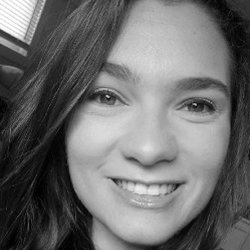News
A Passion for Prototypes
September 6, 2023
Brandon Castellano always knew he would be an engineer. Growing up, he regularly found himself wondering about the mechanical properties that made things work and had a knack for designing and creating. Initially, he thought he would pursue his bachelor’s degree in mechanical engineering to design roller coasters someday.
But then Castellano discovered the College of Engineering and Computing Sciences’ Entrepreneurship and Technology Innovation Center (ETIC) on the Long Island campus and found his true passion for creating prototypes.
In 2022, Castellano was project manager for the New York State Industries for the Disabled’s (NYSID) annual Cultivating Resources for Employment with Assistive TEchnology (CREATE) symposium. His team created the Intelligent Glue Gun, for which they won second place. Castellano is currently in discussions with AHRC Nassau, an organization providing support to those with disabilities, to potentially put the glue gun prototype into mass production. Outfitted with a digital safety checklist, a nontoxic chemical mixture and curing method as an adhesive, and a smart control system to prevent unauthorized use, the glue gun is designed to limit risks to workers with disabilities.
Last year was a busy one for Castellano as he spent the summer working at the Suffolk County Department of Public Works. There he aided in the creation of a proposal for implementing fuel cells in the Emergency Operation Center of Suffolk County as primary and secondary energy sources. He also calculated HVAC energy consumption for Suffolk County Police buildings according to room size and allowable sunlight per room.
This summer, he is interning with Germany’s bonding and welding machine company, Hesse GmbH. Known as Hesse Mechatronics in the United States—Castellano is working out of their Mineola, N.Y., office—the internship is offering him experience in wire bonding (creating electrical interconnection between circuits) for printed circuit boards (PCB), battery cell stacks, and other electronic elements. Lucid Motors, based in California, is one of the main end-users of the parts Castellano is working on.
Back in the ETIC, and about to begin his senior year of undergraduate study, he is project manager for NASA patent project “Pulmonary Unit for Metabolic Analysis” (PUMA). This battery-powered, wearable mask device measures concentrations of carbon dioxide and oxygen in inhaled and exhaled breath, as well as heart rate, temperature, gas pressure, and airflow rates. Wireless data relay allows for real-time analysis—critical for the device’s intended use of preventing hypoxia (insufficient oxygen levels in the body) before symptoms even occur. The mask’s ideal application is for those working in high-intensity, high-stress occupations like firefighters, scuba divers, Navy SEALs, and surgeons.
Along with planning the mask’s circuitry, Castellano has created computer-aided design (CAD) files—a digital rendering—for multiple sensor housing units, the mask’s tube connector, and the housing box containing the battery, Raspberry Pi (a small computer), and breadboard (a component that holds wired electronics together).
His first NASA project, Filtering Molecules with Nanotube Technology, involved assisting in the creation of a CAD file for a filtration unit prototype. He later was able to help with the prototype’s circuitry and Raspberry Pi configuration. The unique prototype uses carbon nanotubes that allow only water to pass through, filtering out and leaving behind any larger molecules and contaminants.
“I love the hands-on work I’m able to perform as part of my studies. Making the connection between classwork and in-field engineering work has been really inspiring,” says Castellano, who is also involved in New York Tech’s chapter of the American Society of Mechanical Engineers (ASME). “I have learned so many skills, both technical and personal, that will contribute to my success down the road.”
After he graduates in 2024, Castellano expects to pursue his master’s degree in mechanical engineering and hopes to secure an internship with NASA that may open the door to full-time work. Ultimately, the budding engineer aspires to be a business owner with a company creating products to help users in their everyday life.
“Find what you want to do, set a goal, and do anything and everything you can in your power to achieve it,” Castellano advises hopeful engineering students. “You can do anything you want if you set your mind to it.”





